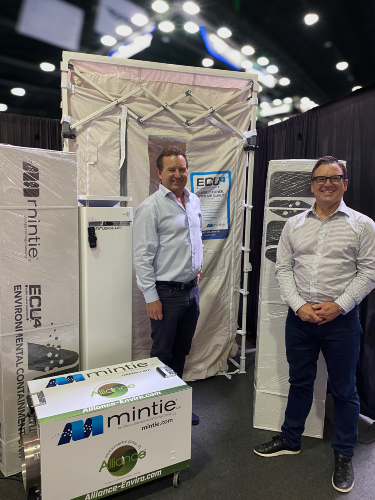But with Covid-19 driving new interest in indoor air quality, Mintie — which was recently acquired by a better capitalized industry player — could turn into more than a niche operation.
Since the Covid pandemic began, Mintie’s annual revenue has roughly tripled from its 2018 level of less than $10 million. And that was before its mobile air isolation units were sent to Japan for the recently concluded Tokyo Olympics. Mintie’s isolation unit is a small portable anteroom set up inside a hospital or other medical facility that serves as a transition air lock between the room where respiratory virus patients are housed and the rest of the facility.
A negative pressure machine pulls air out of the anteroom space, cleans it, then discharges it back into the general facility. The goal is to prevent virus molecules or other contaminants from spreading into the general air circulation.
Mintie contracts with an outside manufacturer to produce the units, which it then markets through third-party distributors.
In the runup to the Tokyo Games, Mintie sold more than 1,000 units to about 400 health care facilities and hotels, by far the highest level of demand for its products.
And the orders kept coming.
“We couldn’t make them fast enough and ship them fast enough. The demand was that high,” said James Mintie, the company’s executive vice president and one of the company founder’s grandsons.
Familiar road
Familiar road
Each time, demand from hospitals surged for Mintie’s mobile air isolation units. Then, when the epidemic receded, so did Mintie’s sales.
As a result, prior to this latest runup, the company’s revenue had barely budged in 20 years. For a Business Journal profile in 1998, Mintie reported $9.7 million in 1997 revenue. According to Chief Executive Kevin Mintie, when the company was sold to Azusa-based Alliance Environmental Group in April 2019, its 2018 revenue was “less than $10 million.”
The key stumbling block to a growth trajectory has been the extremely niche nature of Mintie’s mobile air containment units, according to Russell Olmsted, an industry consultant who has tracked Mintie for nearly 15 years.
“Admittedly, this is a very specialized need,” Olmsted said. “Most hospitals already have some type of containment equipment. It’s only when there’s an extraordinary circumstance that more is needed.”
That circumstance arose last year with the Covid pandemic.
At Orange County Global Medical Center, a Level 2 trauma hospital in Santa Ana, facilities Director Kyle Houraney faced a crush of Covid patients with insufficient means to control air circulation.
Houraney said he was already familiar with Mintie’s mobile air isolation units because the hospital a decade earlier had used federal grants to purchase two of them.
But those units sat mostly unused, except for the occasional training exercise. In April 2020, though, with the Covid crisis appearing to worsen, Houraney said, he ordered six more units from Mintie.
While they worked well, he said a major problem emerged: The base size air isolation units, which measure 2 feet by 4 feet, were too small to accommodate full hospital beds or X-ray equipment.
Houraney said this problem was solved by ordering extensions from Mintie, much like adding leaves to a dinner table. That brought the cost for each unit to nearly $10,000, about four times the cost of the base size unit.
Family tradition ends
Family tradition ends
revenue growth.
The company’s roots go back to 1940 when founder Ernest Mintie began selling air conditioning filters, then gradually expanded into the business of cleaning ventilation systems.
Ernest’s son Bob Mintie took over in 1967. He in turn passed the leadership baton to his own sons, Kevin and James, in the late 1990s, with Kevin serving as chief executive.
But, as with the case at many family-run businesses, the next generation showed no interest in taking over. So, a few years ago, as they neared retirement age, Kevin and James Mintie began looking to sell the company.
At the same time, Alliance Environmental, which had business lines in asbestos and lead abatement, mold remediation and building demolition, was looking to get into the indoor air quality market.
“We, of course, had received offers before, but this time, given that we had no succession from within, the timing was right,” Kevin Mintie said.
An added bonus, he added, was that Alliance, with its deeper pockets, had the resources to commit to grow Mintie’s revenue base.
“This gives us the chance to handle bigger projects and go into bigger territories,” he said.
Under terms of the deal, Mintie gets to keep substantial independence.
The transaction closed in April 2019; financial terms were not disclosed. Mintie’s headquarters was then consolidated from near downtown to Alliance’s Azusa headquarters.
Since then, Alliance Environmental has added another indoor air quality company, James Mintie said.
“Their plan is to grow the indoor air quality side of their business, including Mintie, to $100 million,” he said.
New product
New product
James Mintie said the company aims to begin selling these filters through third-party distribution channels by the end of the year.
Olmsted, the industry consultant, pointed to another use in recent years for Mintie’s mobile air isolation units: seismic retrofitting or other major construction at hospital facilities.
In most hospital construction projects, he said, plastic sheeting is the main method for keeping dust and other particles generated by the construction from rooms for patients with respiratory diseases or conditions.
But, Olmsted said, plastic sheeting is an inferior method to Mintie’s air isolation technology, especially now that the Covid pandemic has put a spotlight on indoor air circulation,
All these developments hold the promise for the company to permanently break out of its revenue rut. The trick now, Olmsted said, lies in the execution.
“Now that they have a parent company, their ability to market these two product lines will be crucial,” he said.

